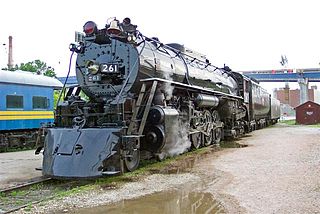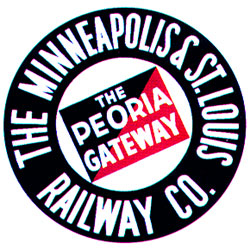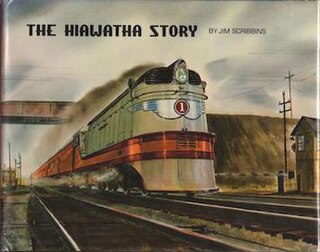
The Chicago, Milwaukee, St. Paul and Pacific Railroad (CMStP&P), better known as the Milwaukee Road, was a Class I railroad that operated in the Midwest and Northwest of the United States from 1847 until 1986.

Milwaukee Road 261 is a class "S3" 4-8-4 "Northern" type steam locomotive built by the American Locomotive Company (ALCO) in Schenectady, New York in July 1944 for the Milwaukee Road.

The Soo Line Railroad is one of the primary United States railroad subsidiaries for the CPKC Railway, one of six U.S. Class I railroads, controlled through the Soo Line Corporation. Although it is named for the Minneapolis, St. Paul and Sault Ste. Marie Railroad (MStP&SSM), which was commonly known as the Soo Line after the phonetic spelling of Sault, it was formed in 1961 by the consolidation of that company with two other CPKC subsidiaries: The Duluth, South Shore and Atlantic Railway, and the Wisconsin Central Railway. It is also the successor to other Class I railroads, including the Minneapolis, Northfield and Southern Railway and the Chicago, Milwaukee, St. Paul and Pacific Railroad. On the other hand, a large amount of mileage was spun off in 1987 to Wisconsin Central Ltd., now part of the Canadian National Railway. The Soo Line Railroad and the Delaware and Hudson Railway, CPKC's other major subsidiary, presently do business as the Canadian Pacific Railway (CP). Most equipment has been repainted into the CP scheme, but the U.S. Surface Transportation Board groups all of the company's U.S. subsidiaries under the Soo Line name for reporting purposes. The Minneapolis headquarters are located in the Canadian Pacific Plaza building, having moved from the nearby Soo Line Building.

The Hiawathas were a fleet of named passenger trains operated by the Chicago, Milwaukee, St. Paul and Pacific Railroad between Chicago and various destinations in the Midwest and Western United States. The most notable of these trains was the original Twin Cities Hiawatha, which served the Twin Cities in Minnesota. The train was named for the epic poem The Song of Hiawatha by Henry Wadsworth Longfellow.

The Chicago and North Western was a Class I railroad in the Midwestern United States. It was also known as the "North Western". The railroad operated more than 5,000 miles (8,000 km) of track at the turn of the 20th century, and over 12,000 miles (19,000 km) of track in seven states before retrenchment in the late 1970s. Until 1972, when the employees purchased the company, it was named the Chicago and North Western Railway.

The EMD FP7 is a 1,500 horsepower (1,100 kW), B-B dual-service passenger and freight-hauling diesel locomotive produced between June 1949 and December 1953 by General Motors' Electro-Motive Division and General Motors Diesel. Final assembly was at GM-EMD's La Grange, Illinois plant, excepting locomotives destined for Canada, in which case final assembly was at GMD's plant in London, Ontario. The FP7 was essentially EMD's F7A locomotive extended by four feet to give greater water capacity for the steam generator for heating passenger trains.

The Iowa, Chicago and Eastern Railroad (IC&E) was a Class II railroad operating in the north central United States. It has been controlled by the Canadian Pacific Railway and operated as a part of its system since October 30, 2008. Formerly, the IC&E was jointly owned with the Dakota, Minnesota and Eastern Railroad by Cedar American Rail Holdings (CARH), making the combined system the largest class II railroad in the United States. Created by the purchase of I&M Rail Link, IC&E commenced operations on July 30, 2002. The 1,400-mile (2,300 km) line, based in Davenport, Iowa, serves the states of Illinois, Iowa, Missouri, Minnesota and Wisconsin. Principal commodities include chemicals, coal, steel, automobiles, and agricultural products. Train dispatching is performed at a joint DM&E/IC&E facility in Sioux Falls, South Dakota. On December 26, 2008, the IC&E was merged into parent CARH, which immediately merged into the DM&E.
The I&M Rail Link was a railroad operating in the north central portion of the United States. The company commenced operations on April 5, 1997, acquiring lines from the Canadian Pacific Railway and Soo Line Railroad.
The following railroads have been named Union Railroad or Union Railway, usually because they connected or merged several other railroads.

Progressive Rail Inc. is a shortline railroad and owner of several other shortlines. PGR is directly operating several separate branches in Minnesota including the Airlake Terminal Railway. Progressive Rail also acquired the Wisconsin Northern Division in Chippewa Falls, Wisconsin and operates as a separately-named division. They also own the Chicago Junction Railroad, Clackamas Valley Railway, the Iowa Traction Railway and Iowa Southern Railway in Iowa, the Piedmont & Northern Railroad, the Crab Orchard and Egyptian Railroad in Illinois, the St. Paul & Pacific Northwest Railroad, and the Wisconsin Northern Railroad.

The Chicago, St. Paul, Minneapolis and Omaha Railway or Omaha Road was a railroad in the U.S. states of Nebraska, Iowa, Minnesota, Wisconsin and South Dakota. It was incorporated in 1880 as a consolidation of the Chicago, St. Paul and Minneapolis Railway and the North Wisconsin Railway. The Chicago and North Western Railway (C&NW) gained control in 1882. The C&NW leased the Omaha Road in 1957 and merged the company into itself in 1972. Portions of the C. St. P. M. and O. are part of the Union Pacific Railroad network. This includes main lines from Wyeville, Wisconsin, to St. Paul, Minnesota, and St. Paul to Sioux City, Iowa.

The Minneapolis and St. Louis Railway (M&StL) was an American Class I railroad that built and operated lines radiating south and west from Minneapolis, Minnesota for 90 years from 1870 to 1960. The railway never reached St. Louis but its North Star Limited passenger train ran to that city via the Wabash Railroad.

Lee is an unincorporated community in Monon Township, White County, in the U.S. state of Indiana.

Wisconsin Central Ltd. is a railroad subsidiary of Canadian National. At one time, its parent Wisconsin Central Transportation Corporation owned or operated railroads in the United States, Canada, the United Kingdom, New Zealand, and Australia.

Charles Sumner Frost was an American architect. He is best known as the architect of Navy Pier and for designing over 100 buildings for the Chicago and North Western Railway.

The Super Dome was a Dome car built by Pullman-Standard for the Chicago, Milwaukee, St. Paul and Pacific Railroad in 1952. The ten Super Domes were the first full-length dome cars in revenue service, first operating on the Olympian Hiawatha and Twin Cities Hiawatha in late 1952. Although a mixed blessing in passenger use, the cars garnered much publicity for the Milwaukee Road and several remain in operation.

The Hiawatha Story is a 1970 non-fiction book on railroad history by Jim Scribbins, then an employee of the Chicago, Milwaukee, St. Paul and Pacific Railroad. The book covers the history of the Milwaukee Road's most famous passenger train, the Hiawatha, from its creation in 1934–1935 up through 1970. The book also covered the various other Milwaukee Road trains which carried the name "Hiawatha."

Samuel L. Rose was an American lawyer, judge, and politician. He was a pioneer settler of Beaver Dam, Wisconsin, and represented that part of the state in the Wisconsin State Senate and State Assembly (1855). He later served as an Iowa circuit court judge and is the namesake of Rose Grove Township, Hamilton County, Iowa.
















